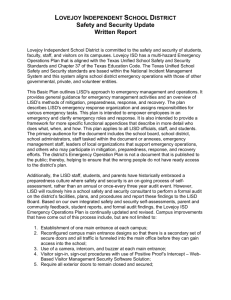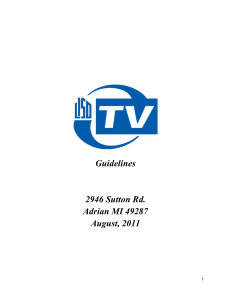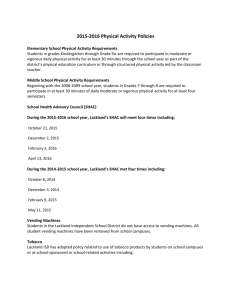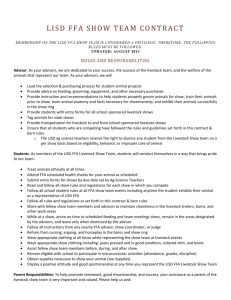Very Hot Humid Days ISD Program Guidelines 6-11
advertisement
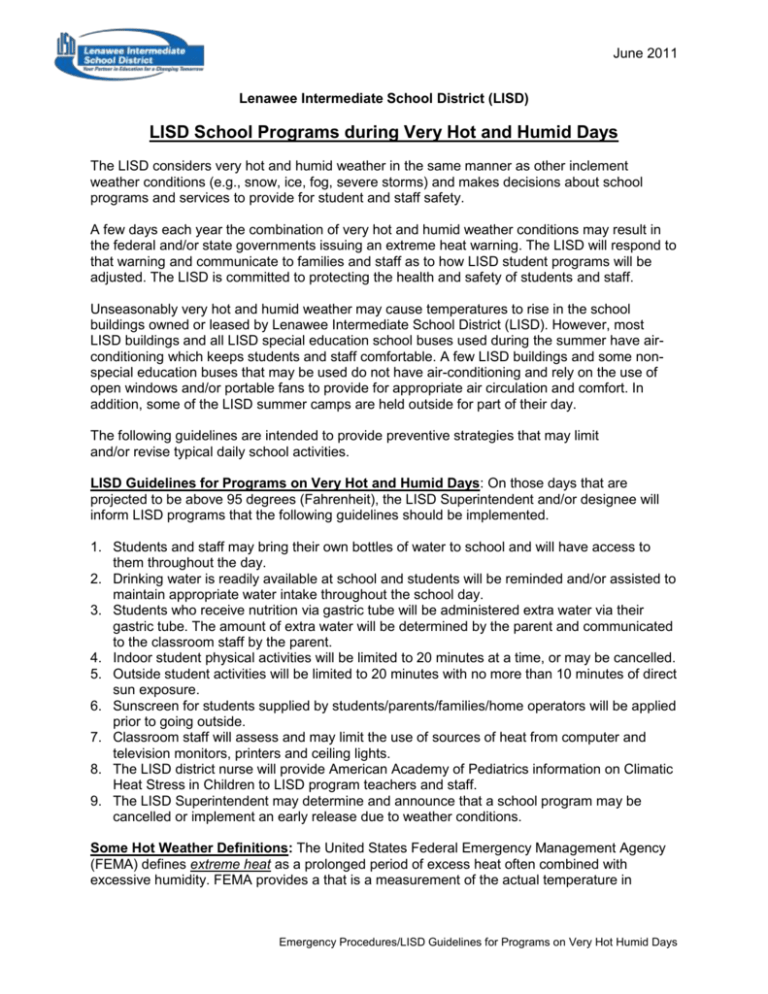
June 2011 Lenawee Intermediate School District (LISD) LISD School Programs during Very Hot and Humid Days The LISD considers very hot and humid weather in the same manner as other inclement weather conditions (e.g., snow, ice, fog, severe storms) and makes decisions about school programs and services to provide for student and staff safety. A few days each year the combination of very hot and humid weather conditions may result in the federal and/or state governments issuing an extreme heat warning. The LISD will respond to that warning and communicate to families and staff as to how LISD student programs will be adjusted. The LISD is committed to protecting the health and safety of students and staff. Unseasonably very hot and humid weather may cause temperatures to rise in the school buildings owned or leased by Lenawee Intermediate School District (LISD). However, most LISD buildings and all LISD special education school buses used during the summer have airconditioning which keeps students and staff comfortable. A few LISD buildings and some nonspecial education buses that may be used do not have air-conditioning and rely on the use of open windows and/or portable fans to provide for appropriate air circulation and comfort. In addition, some of the LISD summer camps are held outside for part of their day. The following guidelines are intended to provide preventive strategies that may limit and/or revise typical daily school activities. LISD Guidelines for Programs on Very Hot and Humid Days: On those days that are projected to be above 95 degrees (Fahrenheit), the LISD Superintendent and/or designee will inform LISD programs that the following guidelines should be implemented. 1. Students and staff may bring their own bottles of water to school and will have access to them throughout the day. 2. Drinking water is readily available at school and students will be reminded and/or assisted to maintain appropriate water intake throughout the school day. 3. Students who receive nutrition via gastric tube will be administered extra water via their gastric tube. The amount of extra water will be determined by the parent and communicated to the classroom staff by the parent. 4. Indoor student physical activities will be limited to 20 minutes at a time, or may be cancelled. 5. Outside student activities will be limited to 20 minutes with no more than 10 minutes of direct sun exposure. 6. Sunscreen for students supplied by students/parents/families/home operators will be applied prior to going outside. 7. Classroom staff will assess and may limit the use of sources of heat from computer and television monitors, printers and ceiling lights. 8. The LISD district nurse will provide American Academy of Pediatrics information on Climatic Heat Stress in Children to LISD program teachers and staff. 9. The LISD Superintendent may determine and announce that a school program may be cancelled or implement an early release due to weather conditions. Some Hot Weather Definitions: The United States Federal Emergency Management Agency (FEMA) defines extreme heat as a prolonged period of excess heat often combined with excessive humidity. FEMA provides a that is a measurement of the actual temperature in Emergency Procedures/LISD Guidelines for Programs on Very Hot Humid Days June 2011 relation to the humidity; it is what the temperature actually “feels like” and an individual’s reaction to this combination will differ. The following two charts from FEMA provide you with a guide when to limit activities during very hot and humid days and how the heat index is determined by the relationship to actual air temperature and relative humidity. References Bureau of Environmental Health (2007). Emergency Response/Indoor Air Quality Program. Methods for Increasing Comfort in Non-Air-Conditioned Schools. Retrieved June 11, 2009 from www.mass.gov Centers for Disease Control & Prevention (2006). Extreme Heat: A Prevention Guide to Promote Your Personal Health and Safety. Retrieved June 11, 2009 from www.bt.cdc.gov/disasters/extremeheat/heat_guide.asp Federal Emergency Management Agency (2009). Extreme Heat. Retrieved June 11, 2009 from http://www.fema.gov/hazard/heat/index.shtm Kyrene School District, Heat Index Guidelines and Procedures (n.d). Retrieved June 11, 2009 from http://www.kyrene.org/hrmandatorytraining/heat/Heat_advisory_plan.pdf Emergency Procedures/LISD Guidelines for Programs on Very Hot Humid Days
